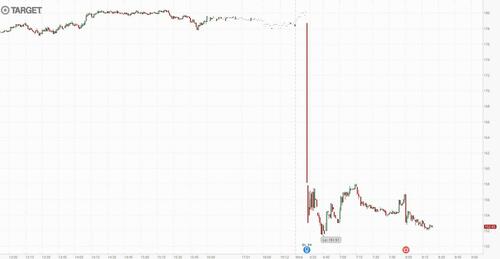Target Tumbles After Cutting Guidance, Warns Consumers Are Pulling Back On Spending
One day after stellar earnings from Walmart sent the stock of the world’s largest traditional retailer soaring, Target spoiled the party when it reported that consumers had pulled back on their spending in recent weeks, sapping sales and profits in the latest quarter and “putting a cloud over its holiday season” as the WSJ put it.
Both sales and earnings missed consensus as well as Target’s own forecasts while sales growth lagged behind larger rival Walmart. Also unlike Walmart which boosted its Q4 and full year guidance, Target executives lowered their financial goals for the holiday quarter “in light of an increasingly challenging environment.”
Here is a snapshot of Q3 earnings:
Sales $26.12 billion, +3.3% y/y, missing estimate $26.38 billion
Comparable sales +2.7% vs. +12.7% y/y, estimate +2.51%
Comp digital sales +0.3% vs. +28.9% y/y, estimate +3.25%
Store comparable sales +3.2% vs. +9.7% y/y, estimate +1.77%
Stores originated sales 82.9% vs. 82.4% y/y, estimate 82%
Gross margin 24.7% vs. 28% y/y, estimate 25.6%
Adjusted EPS $1.54 vs. $3.03 y/y, estimate $2.15
Ebit $1.03 billion, -49% y/y
Ebitda $1.71 billion, -36% y/y, estimate $2.04 billion
Some more details:
Customer transactions +1.4% vs. +12.9% y/y
Average transaction amount +1.3% vs. -0.2% y/y, estimate +0.17% (2 estimates)
Digital sales as share of total sales 17.1% vs. 17.6% y/y
Total stores 1,941, +0.9% y/y, estimate 1,950
Operating margin 3.9% vs. 7.8% y/y, estimate 5.35%
SG&A expense $5.22 billion, +7.4% y/y, estimate $5.1 billion
Operating income $1.02 billion, -49% y/y, estimate $1.36 billion
Looking ahead, this quarter, Target projected a drop in comparable sales, the first decline in five years, and the CEO warned sales trends weakened sharply last month and the company is seeking up to $3 billion in cost cuts but no layoffs.
While the quarterly earnings were subpar, much more ominously Target executives said that sales and profit trends worsened in October and November with guests’ shopping behaviors increasingly affected by inflation, rising interest rates and economic uncertainty. Executives also said consumers are waiting to purchase items until they spot a deal, buying smaller pack sizes and giving priority to family needs. Sales of food, beverage, beauty products and seasonal items were strong, they said.
“Clearly it’s an environment where consumers have been stressed,” said Target Chief Executive Brian Cornell on a call with reporters. “We know they are spending more dollars on food and beverage and household essentials, and as they are shopping for discretionary categories they are looking for promotions.”
Retailers are facing an increasingly uncertain holiday season with high food and gas prices pinching some households. Target, like many of its peers, has been discounting to try to clear out a glut of goods this summer. Target’s inventory rose 14.4% in the October quarter from a year ago, while its revenue rose 3.4%. Quarterly net income tumbled by half.
Walmart gets over half of its U.S. revenue from groceries, while Target’s business is more skewed toward discretionary categories such as home goods, apparel, electronics and beauty products. And as consumers absorb higher prices on core staples, many are pulling back spending where they can.
As the WSJ notes, Target said it is gaining market share in its five main categories, even as consumers pull back spending in some cases. Traffic to stores increased 1.4% in the most recent quarter. Shockingly, the company also revealed that so far this year, Target has lost over $400 million in goods due to shrink, the industry term for theft and other product loss. “We’ve seen that trend has grown over the course of the year,” he said.
Target shares dropped 13% in premarket trading on the earnings, which came in well below Wall Street’s estimates. It is the second time this year the retailer has misjudged consumer demand—in the spring executives said they were surprised by shifts away from furniture and appliances.
Other retailers such as Best Buy and Macy’s also slumped pre-market, dragging S&P 500 futures lower. Target will add to fears about the health of US consumers. Some of Walmart’s strength came from higher-income shoppers trading down, and there’s been a shift to groceries from general merchandise. Retail stocks face further pressure from higher rates amid tighter credit and skyrocketing housing costs. Today’s October retail sales are forecast to rise 1% m/m, but as we warned last night, the number will overstate consumer strength due to a one-time stimmy in California.
Tyler Durden
Wed, 11/16/2022 – 08:26

